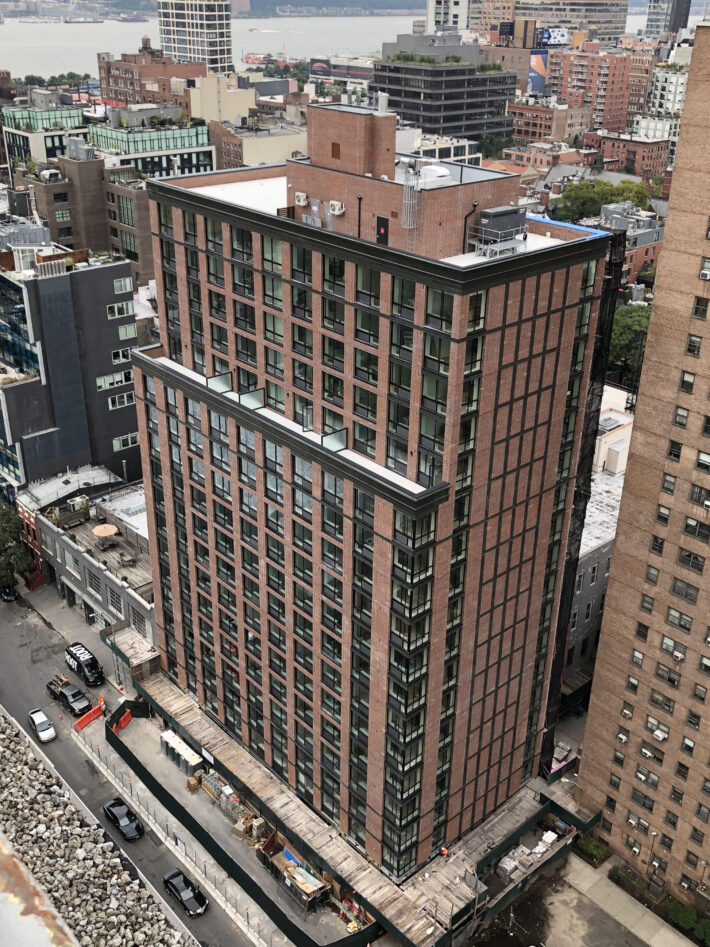
A new 159-unit building that promises to be 100 percent affordable is slated to open by the end of 2018 on West 18th Street between 9th and 10th avenues — but potential applicants find that the definition of affordable can be elusive.
Annual household income requirements for the new development range from 50 to 165 percent of the area median income, a figure calculated by the Department of Housing and Urban Development (HUD) that helps to ascertain eligibility for affordable housing programs. The area medan income ranges from $73,100 for a single person to $121,000 for a family of six.
These figures are designed to attract working- and middle-class families, according to Miguel Acevedo, president of the tenants’ association at the adjacent 944-unit public housing, also known as Fulton Houses. “I’ve spoken to a few police officers, firemen, correctional officers that wanted this opportunity because it’s their only chance of living in the city on their salaries,” he said.
According to Acevedo, 36 of the 159 new units are set aside primarily for current residents of Fulton and two other buildings – Elliott-Chelsea and Harborview Terrace. Half of the remaining 123 units are prioritized for residents of the area covered by Community Board 4, and the other half for people who live outside that district.
He said the threshold for an acceptable credit score in the past has been 650 to 700, considered ‘fair’ by data analytics company FICO, which measures consumer credit risk in the U.S.
And then it gets complicated.
The lottery for applications, run by the Department of Housing Preservation and Development (HPD), closed on September 24, and Acevedo believes the demand was very high. “From my understanding, around 90,000 people may have applied to these units because of the location,” he said. He thinks as many as 80,000 of them will get disqualified because they unintentionally report income inaccurately and fail credit background checks as a result. “Several times in the past, people didn’t realize that bonuses or Medicaid money for drugs contributed to their income,” he said. “I’ve known senior citizens disqualified for being 30, 80 dollars above the bracket, but you still take the chance and apply.”
Applicants who meet the criteria will receive notifications from the developer, Artimus Construction Inc, to come in for interviews – where their proof of income will be established – before the end of October. Around two weeks later, those who pass the credit checks will be shown the apartment available to them, and decide whether they want to move in.
“Successful applicants will receive a certificate of occupancy within a few weeks of completion at the end of the year, after which they can move in,” said HPD Deputy Press Secretary Matthew Creegan. HPD didn’t respond to a query about how unforeseen – but not historically uncommon – completion delays would affect this process.
Linda Rivera, 44, a cook by day and custodian by night, has lived in a two-bedroom apartment at Fulton Houses for 13 years, and she dreams of a brighter future. “You want to better yourself,” she said. “You have 25 floors here with a lot of crazy people, you want a building that is clean, with no piss on the floor, nobody smoking; you want to live in a comfortable area.”
But Rivera is caught between a rock and a hard place. The minimum income requirement for a two-bedroom, two-person apartment at the new development is $91,886, well above what she makes. She would have to pay $2,604 in rent, double her current rent. Rivera lives with her 14-year-old son, who attends a private school, which is a major reason she works two jobs.
Faced with a choice — a nicer apartment and public school, or her current residence and private school — she felt she had no choice at all.“I would rather continue paying for his private school tuition than pay more rent,” she said.
Rivera said she was discouraged from applying by a fellow resident, who told her that her current situation was more favorable to potential income fluctuations. If her income dips now, her rent dips with it — but that isn’t the case at the new building. “When I first came here, I worked a low-income job, and paid only $185 in rent,” she said. “Now I earn over $60,000 a year and pay around $1,300 a month; when I eventually leave one of my jobs, my rent will adjust. But if that happened while I was at the new apartment, I would no longer qualify because I would fall below the original requirement.”
HPD Press Secretary Juliet Pierre-Antoine confirmed Rivera’s understanding, and said rents are generally set through a regulatory agreement with the building owner. “Once an apartment is secured by a tenant, it is the same as any privately-owned rent stabilized apartment,” she said. “Unless the renter holds some sort of rent subsidy such as a section 8 voucher – a federally-funded housing subsidy – rent does not fluctuate based on renters income.”
Acevedo proposed one solution to the problem. “They need to base the brackets on gross, not net income, because a good chunk is taken away in taxes, and this is what shuts people out of the process,” he said. “It needs to be changed, to make It really affordable.” HPD didn’t comment on this matter.
The project was initially proposed in 2005, and supported by then-Mayor Michael Bloomberg. But delays followed, which Acevedo attributes to a lack of funding. “You get tax-exempt bonds from the government to help subsidize buildings, but that money wasn’t available for years,” he said. “Even when de Blasio came in, there was still no money, until recently; construction finally started in May 2017.”
Such details matter little to Rivera, though. “I don’t understand how this all works, I’m just going to stay where I’m at,” she said. “It’s a problem because I can’t move on.”